Implementing Lean Project Management for the FIFA 2018 World Cup
VerifiedAdded on 2023/06/07
|14
|3733
|294
Report
AI Summary
This report provides a comprehensive analysis of the project management strategies employed for the FIFA 2018 World Cup. It begins by defining key concepts such as Voice of the Customer (VOC), Critical to Customer Requirements (CCR), and Critical to Quality Parameters (CQP) within the context of the tournament. The report then delves into the implementation of lean project management, exploring the application of various methodologies including PMBOK process groups (Initiation, Planning, Executing, Monitoring and Control, and Closing), PRINCE2 processes (Starting up a project, Initiating a project, Directing a project, Controlling a stage, Managing a Stage Boundary, Managing Product Delivery, and Closing a Project), Agile Management Process, and Lean Six Sigma (DMAIC Methodology). Each methodology is examined in detail, with specific examples of how they could have been applied to the FIFA 2018 World Cup to ensure successful project outcomes. The report also offers recommendations for future events and concludes with a summary of the key findings, emphasizing the importance of customer focus, quality control, and efficient processes in managing large-scale projects.

qwertyuiopasdfghjklzxcvbnmqw
ertyuiopasdfghjklzxcvbnmqwert
yuiopasdfghjklzxcvbnmqwertyui
opasdfghjklzxcvbnmqwertyuiop
asdfghjklzxcvbnmqwertyuiopasd
fghjklzxcvbnmqwertyuiopasdfgh
jklzxcvbnmqwertyuiopasdfghjkl
zxcvbnmqwertyuiopasdfghjklzxc
vbnmqwertyuiopasdfghjklzxcvb
nmqwertyuiopasdfghjklzxcvbnm
qwertyuiopasdfghjklzxcvbnmqw
ertyuiopasdfghjklzxcvbnmqwert
yuiopasdfghjklzxcvbnmqwertyui
opasdfghjklzxcvbnmqwertyuiop
asdfghjklzxcvbnmqwertyuiopasd
fghjklzxcvbnmqwertyuiopasdfgh
jklzxcvbnmrtyuiopasdfghjklzxcv
Project Management
FIFA 2018 World Cup
9/4/2018
ertyuiopasdfghjklzxcvbnmqwert
yuiopasdfghjklzxcvbnmqwertyui
opasdfghjklzxcvbnmqwertyuiop
asdfghjklzxcvbnmqwertyuiopasd
fghjklzxcvbnmqwertyuiopasdfgh
jklzxcvbnmqwertyuiopasdfghjkl
zxcvbnmqwertyuiopasdfghjklzxc
vbnmqwertyuiopasdfghjklzxcvb
nmqwertyuiopasdfghjklzxcvbnm
qwertyuiopasdfghjklzxcvbnmqw
ertyuiopasdfghjklzxcvbnmqwert
yuiopasdfghjklzxcvbnmqwertyui
opasdfghjklzxcvbnmqwertyuiop
asdfghjklzxcvbnmqwertyuiopasd
fghjklzxcvbnmqwertyuiopasdfgh
jklzxcvbnmrtyuiopasdfghjklzxcv
Project Management
FIFA 2018 World Cup
9/4/2018
Paraphrase This Document
Need a fresh take? Get an instant paraphrase of this document with our AI Paraphraser
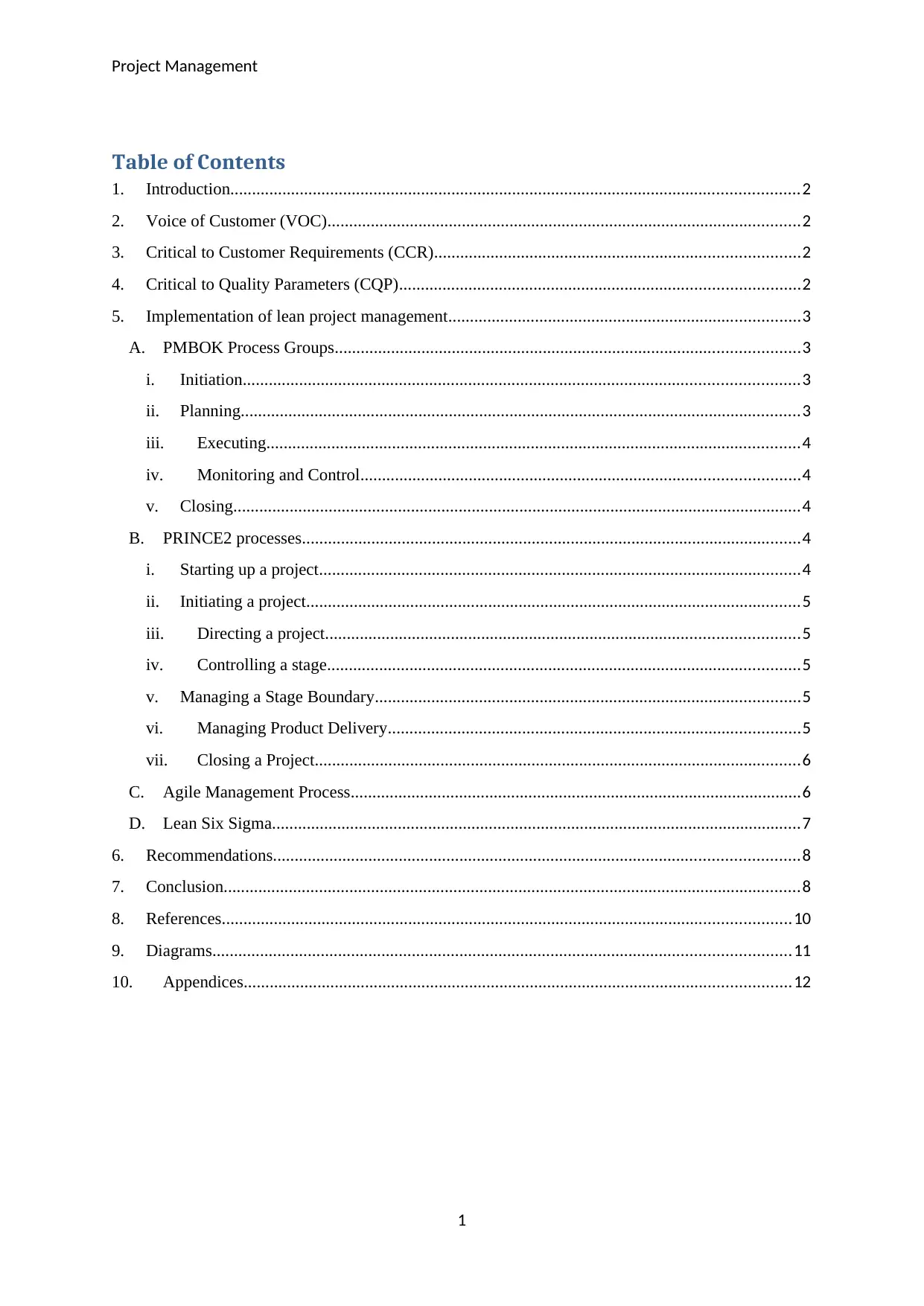
Project Management
Table of Contents
1. Introduction...................................................................................................................................2
2. Voice of Customer (VOC).............................................................................................................2
3. Critical to Customer Requirements (CCR)....................................................................................2
4. Critical to Quality Parameters (CQP)............................................................................................2
5. Implementation of lean project management.................................................................................3
A. PMBOK Process Groups...........................................................................................................3
i. Initiation................................................................................................................................3
ii. Planning.................................................................................................................................3
iii. Executing...........................................................................................................................4
iv. Monitoring and Control.....................................................................................................4
v. Closing...................................................................................................................................4
B. PRINCE2 processes...................................................................................................................4
i. Starting up a project...............................................................................................................4
ii. Initiating a project..................................................................................................................5
iii. Directing a project.............................................................................................................5
iv. Controlling a stage.............................................................................................................5
v. Managing a Stage Boundary..................................................................................................5
vi. Managing Product Delivery...............................................................................................5
vii. Closing a Project................................................................................................................6
C. Agile Management Process........................................................................................................6
D. Lean Six Sigma..........................................................................................................................7
6. Recommendations.........................................................................................................................8
7. Conclusion.....................................................................................................................................8
8. References...................................................................................................................................10
9. Diagrams.....................................................................................................................................11
10. Appendices..............................................................................................................................12
1
Table of Contents
1. Introduction...................................................................................................................................2
2. Voice of Customer (VOC).............................................................................................................2
3. Critical to Customer Requirements (CCR)....................................................................................2
4. Critical to Quality Parameters (CQP)............................................................................................2
5. Implementation of lean project management.................................................................................3
A. PMBOK Process Groups...........................................................................................................3
i. Initiation................................................................................................................................3
ii. Planning.................................................................................................................................3
iii. Executing...........................................................................................................................4
iv. Monitoring and Control.....................................................................................................4
v. Closing...................................................................................................................................4
B. PRINCE2 processes...................................................................................................................4
i. Starting up a project...............................................................................................................4
ii. Initiating a project..................................................................................................................5
iii. Directing a project.............................................................................................................5
iv. Controlling a stage.............................................................................................................5
v. Managing a Stage Boundary..................................................................................................5
vi. Managing Product Delivery...............................................................................................5
vii. Closing a Project................................................................................................................6
C. Agile Management Process........................................................................................................6
D. Lean Six Sigma..........................................................................................................................7
6. Recommendations.........................................................................................................................8
7. Conclusion.....................................................................................................................................8
8. References...................................................................................................................................10
9. Diagrams.....................................................................................................................................11
10. Appendices..............................................................................................................................12
1
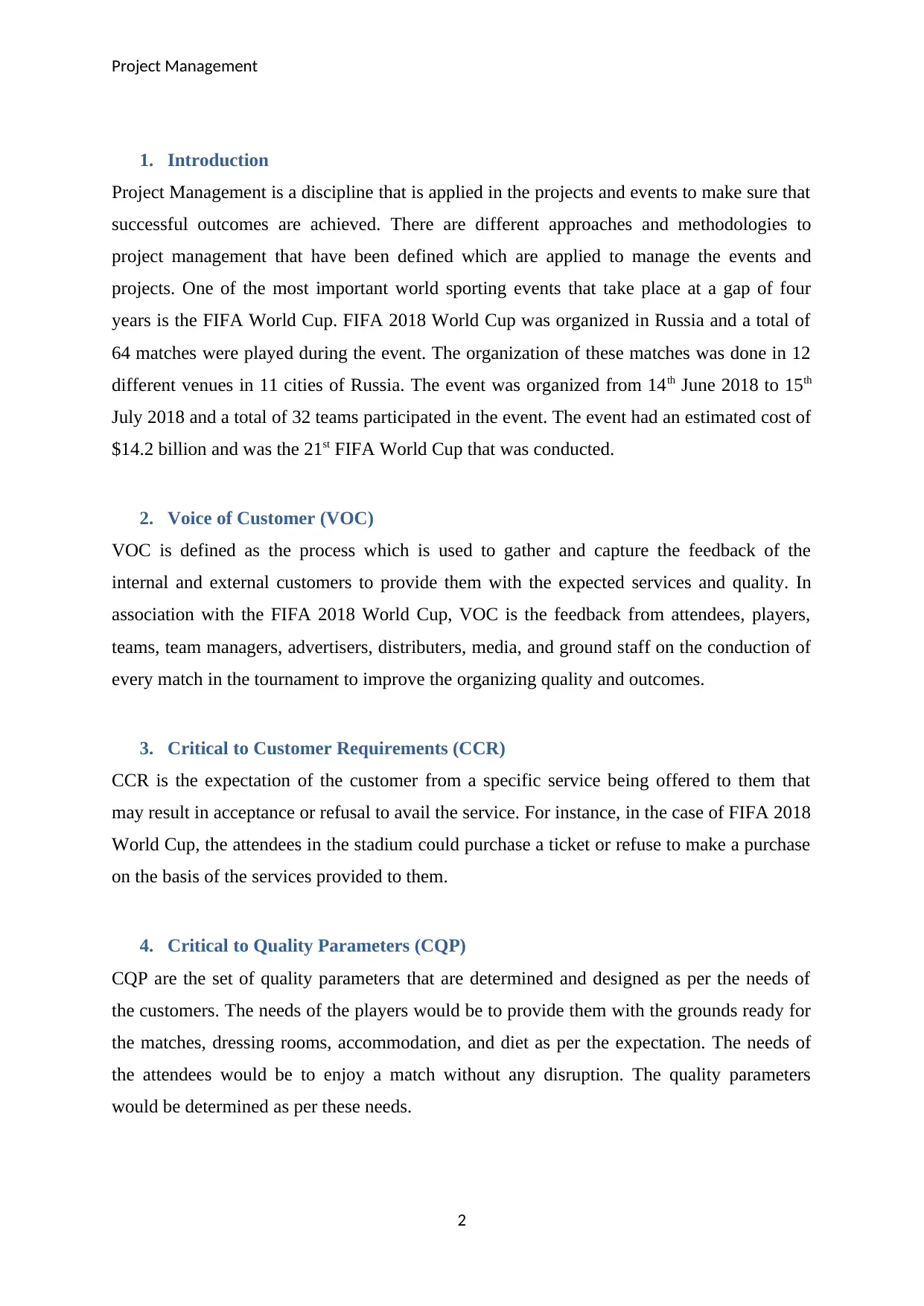
Project Management
1. Introduction
Project Management is a discipline that is applied in the projects and events to make sure that
successful outcomes are achieved. There are different approaches and methodologies to
project management that have been defined which are applied to manage the events and
projects. One of the most important world sporting events that take place at a gap of four
years is the FIFA World Cup. FIFA 2018 World Cup was organized in Russia and a total of
64 matches were played during the event. The organization of these matches was done in 12
different venues in 11 cities of Russia. The event was organized from 14th June 2018 to 15th
July 2018 and a total of 32 teams participated in the event. The event had an estimated cost of
$14.2 billion and was the 21st FIFA World Cup that was conducted.
2. Voice of Customer (VOC)
VOC is defined as the process which is used to gather and capture the feedback of the
internal and external customers to provide them with the expected services and quality. In
association with the FIFA 2018 World Cup, VOC is the feedback from attendees, players,
teams, team managers, advertisers, distributers, media, and ground staff on the conduction of
every match in the tournament to improve the organizing quality and outcomes.
3. Critical to Customer Requirements (CCR)
CCR is the expectation of the customer from a specific service being offered to them that
may result in acceptance or refusal to avail the service. For instance, in the case of FIFA 2018
World Cup, the attendees in the stadium could purchase a ticket or refuse to make a purchase
on the basis of the services provided to them.
4. Critical to Quality Parameters (CQP)
CQP are the set of quality parameters that are determined and designed as per the needs of
the customers. The needs of the players would be to provide them with the grounds ready for
the matches, dressing rooms, accommodation, and diet as per the expectation. The needs of
the attendees would be to enjoy a match without any disruption. The quality parameters
would be determined as per these needs.
2
1. Introduction
Project Management is a discipline that is applied in the projects and events to make sure that
successful outcomes are achieved. There are different approaches and methodologies to
project management that have been defined which are applied to manage the events and
projects. One of the most important world sporting events that take place at a gap of four
years is the FIFA World Cup. FIFA 2018 World Cup was organized in Russia and a total of
64 matches were played during the event. The organization of these matches was done in 12
different venues in 11 cities of Russia. The event was organized from 14th June 2018 to 15th
July 2018 and a total of 32 teams participated in the event. The event had an estimated cost of
$14.2 billion and was the 21st FIFA World Cup that was conducted.
2. Voice of Customer (VOC)
VOC is defined as the process which is used to gather and capture the feedback of the
internal and external customers to provide them with the expected services and quality. In
association with the FIFA 2018 World Cup, VOC is the feedback from attendees, players,
teams, team managers, advertisers, distributers, media, and ground staff on the conduction of
every match in the tournament to improve the organizing quality and outcomes.
3. Critical to Customer Requirements (CCR)
CCR is the expectation of the customer from a specific service being offered to them that
may result in acceptance or refusal to avail the service. For instance, in the case of FIFA 2018
World Cup, the attendees in the stadium could purchase a ticket or refuse to make a purchase
on the basis of the services provided to them.
4. Critical to Quality Parameters (CQP)
CQP are the set of quality parameters that are determined and designed as per the needs of
the customers. The needs of the players would be to provide them with the grounds ready for
the matches, dressing rooms, accommodation, and diet as per the expectation. The needs of
the attendees would be to enjoy a match without any disruption. The quality parameters
would be determined as per these needs.
2
⊘ This is a preview!⊘
Do you want full access?
Subscribe today to unlock all pages.

Trusted by 1+ million students worldwide
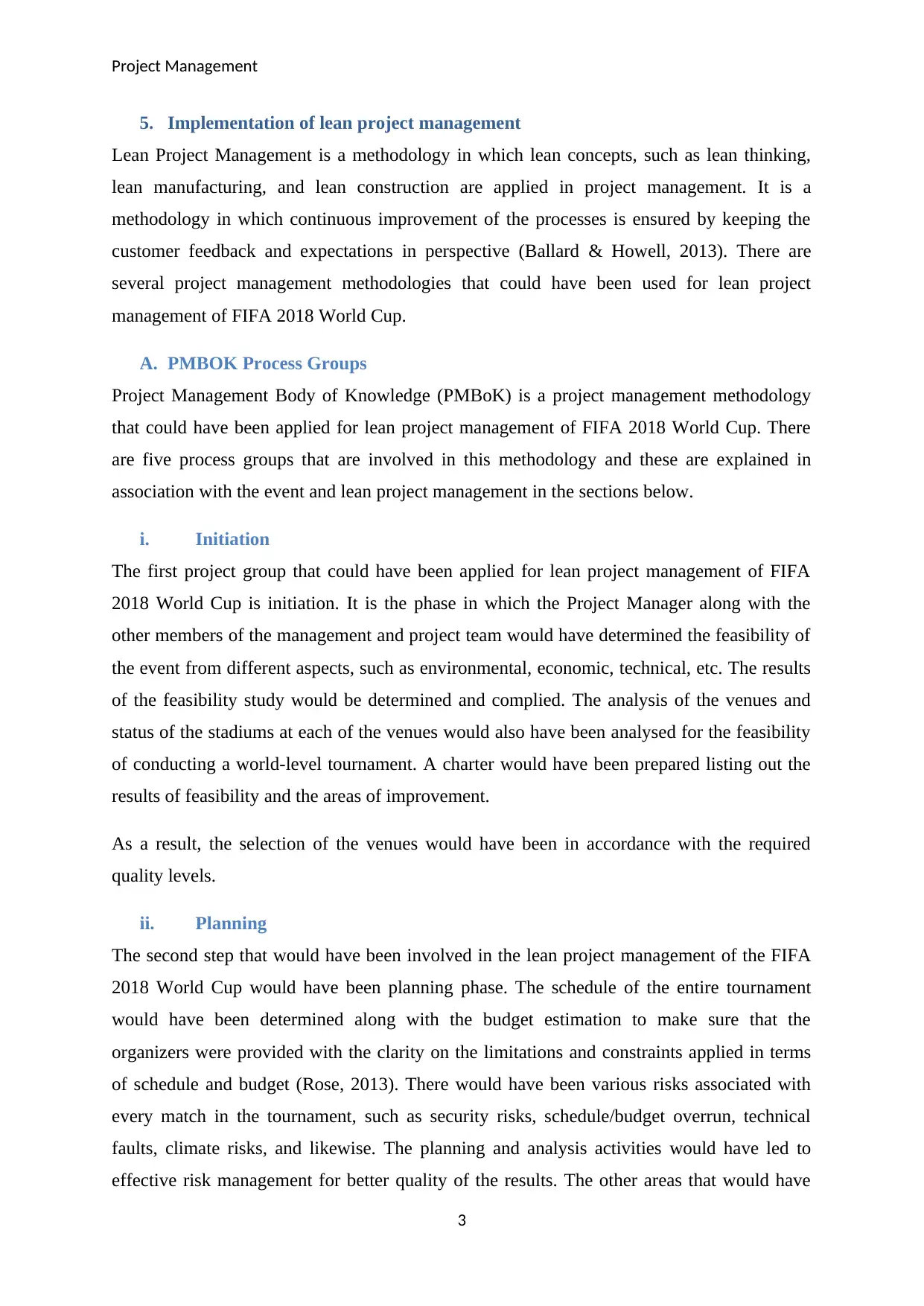
Project Management
5. Implementation of lean project management
Lean Project Management is a methodology in which lean concepts, such as lean thinking,
lean manufacturing, and lean construction are applied in project management. It is a
methodology in which continuous improvement of the processes is ensured by keeping the
customer feedback and expectations in perspective (Ballard & Howell, 2013). There are
several project management methodologies that could have been used for lean project
management of FIFA 2018 World Cup.
A. PMBOK Process Groups
Project Management Body of Knowledge (PMBoK) is a project management methodology
that could have been applied for lean project management of FIFA 2018 World Cup. There
are five process groups that are involved in this methodology and these are explained in
association with the event and lean project management in the sections below.
i. Initiation
The first project group that could have been applied for lean project management of FIFA
2018 World Cup is initiation. It is the phase in which the Project Manager along with the
other members of the management and project team would have determined the feasibility of
the event from different aspects, such as environmental, economic, technical, etc. The results
of the feasibility study would be determined and complied. The analysis of the venues and
status of the stadiums at each of the venues would also have been analysed for the feasibility
of conducting a world-level tournament. A charter would have been prepared listing out the
results of feasibility and the areas of improvement.
As a result, the selection of the venues would have been in accordance with the required
quality levels.
ii. Planning
The second step that would have been involved in the lean project management of the FIFA
2018 World Cup would have been planning phase. The schedule of the entire tournament
would have been determined along with the budget estimation to make sure that the
organizers were provided with the clarity on the limitations and constraints applied in terms
of schedule and budget (Rose, 2013). There would have been various risks associated with
every match in the tournament, such as security risks, schedule/budget overrun, technical
faults, climate risks, and likewise. The planning and analysis activities would have led to
effective risk management for better quality of the results. The other areas that would have
3
5. Implementation of lean project management
Lean Project Management is a methodology in which lean concepts, such as lean thinking,
lean manufacturing, and lean construction are applied in project management. It is a
methodology in which continuous improvement of the processes is ensured by keeping the
customer feedback and expectations in perspective (Ballard & Howell, 2013). There are
several project management methodologies that could have been used for lean project
management of FIFA 2018 World Cup.
A. PMBOK Process Groups
Project Management Body of Knowledge (PMBoK) is a project management methodology
that could have been applied for lean project management of FIFA 2018 World Cup. There
are five process groups that are involved in this methodology and these are explained in
association with the event and lean project management in the sections below.
i. Initiation
The first project group that could have been applied for lean project management of FIFA
2018 World Cup is initiation. It is the phase in which the Project Manager along with the
other members of the management and project team would have determined the feasibility of
the event from different aspects, such as environmental, economic, technical, etc. The results
of the feasibility study would be determined and complied. The analysis of the venues and
status of the stadiums at each of the venues would also have been analysed for the feasibility
of conducting a world-level tournament. A charter would have been prepared listing out the
results of feasibility and the areas of improvement.
As a result, the selection of the venues would have been in accordance with the required
quality levels.
ii. Planning
The second step that would have been involved in the lean project management of the FIFA
2018 World Cup would have been planning phase. The schedule of the entire tournament
would have been determined along with the budget estimation to make sure that the
organizers were provided with the clarity on the limitations and constraints applied in terms
of schedule and budget (Rose, 2013). There would have been various risks associated with
every match in the tournament, such as security risks, schedule/budget overrun, technical
faults, climate risks, and likewise. The planning and analysis activities would have led to
effective risk management for better quality of the results. The other areas that would have
3
Paraphrase This Document
Need a fresh take? Get an instant paraphrase of this document with our AI Paraphraser
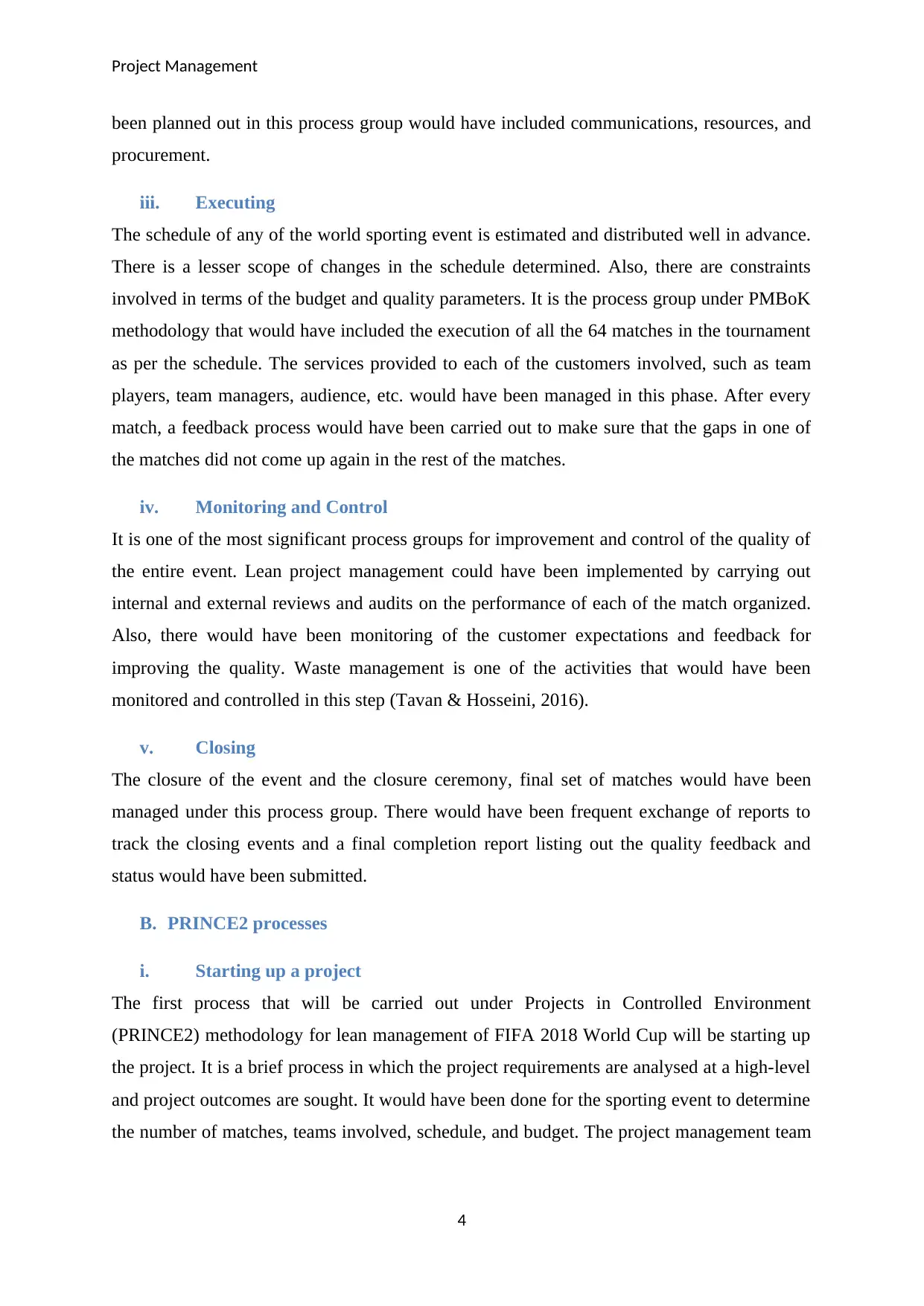
Project Management
been planned out in this process group would have included communications, resources, and
procurement.
iii. Executing
The schedule of any of the world sporting event is estimated and distributed well in advance.
There is a lesser scope of changes in the schedule determined. Also, there are constraints
involved in terms of the budget and quality parameters. It is the process group under PMBoK
methodology that would have included the execution of all the 64 matches in the tournament
as per the schedule. The services provided to each of the customers involved, such as team
players, team managers, audience, etc. would have been managed in this phase. After every
match, a feedback process would have been carried out to make sure that the gaps in one of
the matches did not come up again in the rest of the matches.
iv. Monitoring and Control
It is one of the most significant process groups for improvement and control of the quality of
the entire event. Lean project management could have been implemented by carrying out
internal and external reviews and audits on the performance of each of the match organized.
Also, there would have been monitoring of the customer expectations and feedback for
improving the quality. Waste management is one of the activities that would have been
monitored and controlled in this step (Tavan & Hosseini, 2016).
v. Closing
The closure of the event and the closure ceremony, final set of matches would have been
managed under this process group. There would have been frequent exchange of reports to
track the closing events and a final completion report listing out the quality feedback and
status would have been submitted.
B. PRINCE2 processes
i. Starting up a project
The first process that will be carried out under Projects in Controlled Environment
(PRINCE2) methodology for lean management of FIFA 2018 World Cup will be starting up
the project. It is a brief process in which the project requirements are analysed at a high-level
and project outcomes are sought. It would have been done for the sporting event to determine
the number of matches, teams involved, schedule, and budget. The project management team
4
been planned out in this process group would have included communications, resources, and
procurement.
iii. Executing
The schedule of any of the world sporting event is estimated and distributed well in advance.
There is a lesser scope of changes in the schedule determined. Also, there are constraints
involved in terms of the budget and quality parameters. It is the process group under PMBoK
methodology that would have included the execution of all the 64 matches in the tournament
as per the schedule. The services provided to each of the customers involved, such as team
players, team managers, audience, etc. would have been managed in this phase. After every
match, a feedback process would have been carried out to make sure that the gaps in one of
the matches did not come up again in the rest of the matches.
iv. Monitoring and Control
It is one of the most significant process groups for improvement and control of the quality of
the entire event. Lean project management could have been implemented by carrying out
internal and external reviews and audits on the performance of each of the match organized.
Also, there would have been monitoring of the customer expectations and feedback for
improving the quality. Waste management is one of the activities that would have been
monitored and controlled in this step (Tavan & Hosseini, 2016).
v. Closing
The closure of the event and the closure ceremony, final set of matches would have been
managed under this process group. There would have been frequent exchange of reports to
track the closing events and a final completion report listing out the quality feedback and
status would have been submitted.
B. PRINCE2 processes
i. Starting up a project
The first process that will be carried out under Projects in Controlled Environment
(PRINCE2) methodology for lean management of FIFA 2018 World Cup will be starting up
the project. It is a brief process in which the project requirements are analysed at a high-level
and project outcomes are sought. It would have been done for the sporting event to determine
the number of matches, teams involved, schedule, and budget. The project management team
4

Project Management
would have been selected in this process and the necessary information would have been
shared to enhance the clarity levels of each of the team members.
ii. Initiating a project
The second stage in the project would have been initiation of the project by determining the
feasibility and justification of the World Cup. The business case around the managerial
requirements would have been prepared under this stage. The commitment of the resources
involved in the project team would have been ensured as well. A baseline for the decision-
making processes and activities would have also been developed in this stage. All of the
activities would have ensured that the base for managing and organizing the project was
improved for better quality outcomes (Vanickova, 2017).
iii. Directing a project
This is the stage which is carried out from the start-up of the project till the closure of the
project. The Project Board is responsible for the direction of the project. The primary stages
that are involved in this stage include initiation, stage boundaries, monitoring, and closure.
The stage would have been involved in the FIFA 2018 World Cup for lean project
management.
iv. Controlling a stage
It is one of the most significant process groups for improvement and control of the quality of
the entire event. Lean project management could have been implemented by carrying out
internal and external reviews and audits on the performance of each of the match organized.
Also, there would have been monitoring of the customer expectations and feedback for
improving the quality (Pai, 2010).
v. Managing a Stage Boundary
This is the stage that is involved in the project to make sure that the project shall be continued
or not. In the case of FIFA 2018 World Cup, this is the stage that will be used to make sure
that the deliverables are planned and delivered as per the determined schedule. The continuity
of the project viability will be ensured in this stage of the project. The project quality will be
improved upon in this stage.
vi. Managing Product Delivery
The product deliveries will be managed and planned as per the determined schedule and
budget. The FIFA 2018 World Cup will be managed as per the principles of lean project
5
would have been selected in this process and the necessary information would have been
shared to enhance the clarity levels of each of the team members.
ii. Initiating a project
The second stage in the project would have been initiation of the project by determining the
feasibility and justification of the World Cup. The business case around the managerial
requirements would have been prepared under this stage. The commitment of the resources
involved in the project team would have been ensured as well. A baseline for the decision-
making processes and activities would have also been developed in this stage. All of the
activities would have ensured that the base for managing and organizing the project was
improved for better quality outcomes (Vanickova, 2017).
iii. Directing a project
This is the stage which is carried out from the start-up of the project till the closure of the
project. The Project Board is responsible for the direction of the project. The primary stages
that are involved in this stage include initiation, stage boundaries, monitoring, and closure.
The stage would have been involved in the FIFA 2018 World Cup for lean project
management.
iv. Controlling a stage
It is one of the most significant process groups for improvement and control of the quality of
the entire event. Lean project management could have been implemented by carrying out
internal and external reviews and audits on the performance of each of the match organized.
Also, there would have been monitoring of the customer expectations and feedback for
improving the quality (Pai, 2010).
v. Managing a Stage Boundary
This is the stage that is involved in the project to make sure that the project shall be continued
or not. In the case of FIFA 2018 World Cup, this is the stage that will be used to make sure
that the deliverables are planned and delivered as per the determined schedule. The continuity
of the project viability will be ensured in this stage of the project. The project quality will be
improved upon in this stage.
vi. Managing Product Delivery
The product deliveries will be managed and planned as per the determined schedule and
budget. The FIFA 2018 World Cup will be managed as per the principles of lean project
5
⊘ This is a preview!⊘
Do you want full access?
Subscribe today to unlock all pages.

Trusted by 1+ million students worldwide

Project Management
management using this stage of PRINCE2. This will make sure that the product deliverables
are provided as per the expectations of the stakeholders involved.
vii. Closing a Project
The closure of the event and the closure ceremony, final set of matches would have been
managed under this process group. There would have been frequent exchange of reports to
track the closing events and a final completion report listing out the quality feedback and
status would have been submitted (Jamali & Overisi, 2016).
C. Agile Management Process
It is an adaptive methodology that is used for the purpose of project management. In this
methodology, the management of the project activities is done as per the ad-hoc
methodology. There is no pre-defined set of steps or phases that are involved in this
methodology and the managerial decisions are made on the basis of the requirements of the
project and the project scenarios.
Agile management would have allowed the implementation of lean project management in
the case of FIFA 2018 World Cup. It would have been applied by gathering all the
information and requirements associated with the project. The managerial activities would
have been carried out in a series of iterations which are referred as sprints in terms of the
agile framework. Each of these sprints would have focussed upon a specific project
management activities, such as planning, executing, or controlling. The 64 matches involved
in the tournament would have been classified and allotted to the sprints involved in the agile
project management. The execution of the matches would have been streamlined as an
outcome (Stare, 2014).
There are certain benefits that are associated with the agile process of project management.
The first and the foremost is the customer interaction that is a part of all the agile processes.
In the management activities that would have been carried out, the customer feedback would
have been placed at the top priority. The customer feedback would have been collected as a
regular activity which would have assisted in the lean project management. Both of these
methodologies place the customers at the top and the activities are carried out to ensure that
the customers are satisfied and provided with the expected set of requirements. The use of the
methodology for the management of the FIFA World Cup would have made sure that the
team players and managers along with the organizers, advertisers, distributers, and audience
was kept satisfied by maintaining a frequent interaction with them (Leybourne, 2009).
6
management using this stage of PRINCE2. This will make sure that the product deliverables
are provided as per the expectations of the stakeholders involved.
vii. Closing a Project
The closure of the event and the closure ceremony, final set of matches would have been
managed under this process group. There would have been frequent exchange of reports to
track the closing events and a final completion report listing out the quality feedback and
status would have been submitted (Jamali & Overisi, 2016).
C. Agile Management Process
It is an adaptive methodology that is used for the purpose of project management. In this
methodology, the management of the project activities is done as per the ad-hoc
methodology. There is no pre-defined set of steps or phases that are involved in this
methodology and the managerial decisions are made on the basis of the requirements of the
project and the project scenarios.
Agile management would have allowed the implementation of lean project management in
the case of FIFA 2018 World Cup. It would have been applied by gathering all the
information and requirements associated with the project. The managerial activities would
have been carried out in a series of iterations which are referred as sprints in terms of the
agile framework. Each of these sprints would have focussed upon a specific project
management activities, such as planning, executing, or controlling. The 64 matches involved
in the tournament would have been classified and allotted to the sprints involved in the agile
project management. The execution of the matches would have been streamlined as an
outcome (Stare, 2014).
There are certain benefits that are associated with the agile process of project management.
The first and the foremost is the customer interaction that is a part of all the agile processes.
In the management activities that would have been carried out, the customer feedback would
have been placed at the top priority. The customer feedback would have been collected as a
regular activity which would have assisted in the lean project management. Both of these
methodologies place the customers at the top and the activities are carried out to ensure that
the customers are satisfied and provided with the expected set of requirements. The use of the
methodology for the management of the FIFA World Cup would have made sure that the
team players and managers along with the organizers, advertisers, distributers, and audience
was kept satisfied by maintaining a frequent interaction with them (Leybourne, 2009).
6
Paraphrase This Document
Need a fresh take? Get an instant paraphrase of this document with our AI Paraphraser
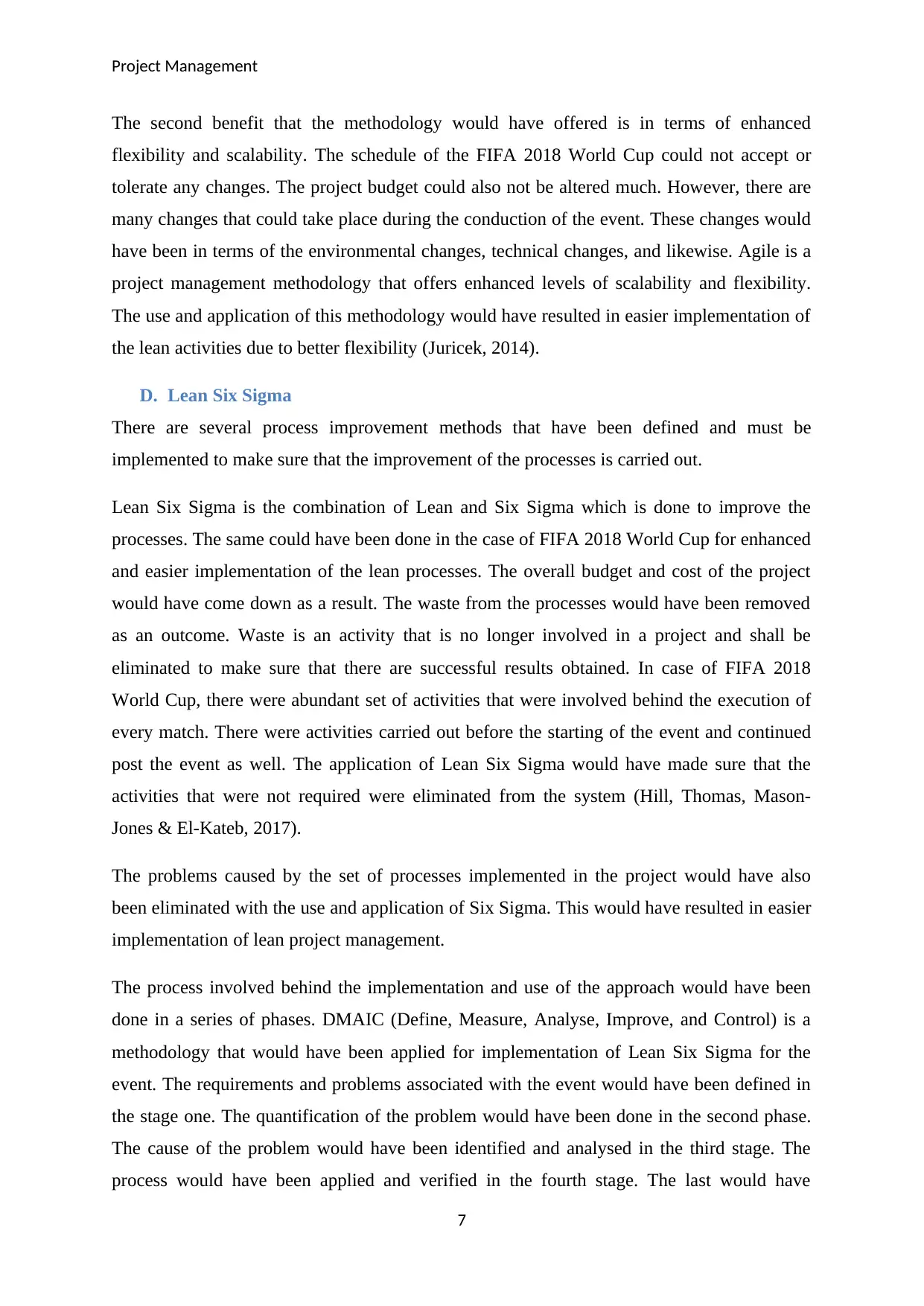
Project Management
The second benefit that the methodology would have offered is in terms of enhanced
flexibility and scalability. The schedule of the FIFA 2018 World Cup could not accept or
tolerate any changes. The project budget could also not be altered much. However, there are
many changes that could take place during the conduction of the event. These changes would
have been in terms of the environmental changes, technical changes, and likewise. Agile is a
project management methodology that offers enhanced levels of scalability and flexibility.
The use and application of this methodology would have resulted in easier implementation of
the lean activities due to better flexibility (Juricek, 2014).
D. Lean Six Sigma
There are several process improvement methods that have been defined and must be
implemented to make sure that the improvement of the processes is carried out.
Lean Six Sigma is the combination of Lean and Six Sigma which is done to improve the
processes. The same could have been done in the case of FIFA 2018 World Cup for enhanced
and easier implementation of the lean processes. The overall budget and cost of the project
would have come down as a result. The waste from the processes would have been removed
as an outcome. Waste is an activity that is no longer involved in a project and shall be
eliminated to make sure that there are successful results obtained. In case of FIFA 2018
World Cup, there were abundant set of activities that were involved behind the execution of
every match. There were activities carried out before the starting of the event and continued
post the event as well. The application of Lean Six Sigma would have made sure that the
activities that were not required were eliminated from the system (Hill, Thomas, Mason-
Jones & El-Kateb, 2017).
The problems caused by the set of processes implemented in the project would have also
been eliminated with the use and application of Six Sigma. This would have resulted in easier
implementation of lean project management.
The process involved behind the implementation and use of the approach would have been
done in a series of phases. DMAIC (Define, Measure, Analyse, Improve, and Control) is a
methodology that would have been applied for implementation of Lean Six Sigma for the
event. The requirements and problems associated with the event would have been defined in
the stage one. The quantification of the problem would have been done in the second phase.
The cause of the problem would have been identified and analysed in the third stage. The
process would have been applied and verified in the fourth stage. The last would have
7
The second benefit that the methodology would have offered is in terms of enhanced
flexibility and scalability. The schedule of the FIFA 2018 World Cup could not accept or
tolerate any changes. The project budget could also not be altered much. However, there are
many changes that could take place during the conduction of the event. These changes would
have been in terms of the environmental changes, technical changes, and likewise. Agile is a
project management methodology that offers enhanced levels of scalability and flexibility.
The use and application of this methodology would have resulted in easier implementation of
the lean activities due to better flexibility (Juricek, 2014).
D. Lean Six Sigma
There are several process improvement methods that have been defined and must be
implemented to make sure that the improvement of the processes is carried out.
Lean Six Sigma is the combination of Lean and Six Sigma which is done to improve the
processes. The same could have been done in the case of FIFA 2018 World Cup for enhanced
and easier implementation of the lean processes. The overall budget and cost of the project
would have come down as a result. The waste from the processes would have been removed
as an outcome. Waste is an activity that is no longer involved in a project and shall be
eliminated to make sure that there are successful results obtained. In case of FIFA 2018
World Cup, there were abundant set of activities that were involved behind the execution of
every match. There were activities carried out before the starting of the event and continued
post the event as well. The application of Lean Six Sigma would have made sure that the
activities that were not required were eliminated from the system (Hill, Thomas, Mason-
Jones & El-Kateb, 2017).
The problems caused by the set of processes implemented in the project would have also
been eliminated with the use and application of Six Sigma. This would have resulted in easier
implementation of lean project management.
The process involved behind the implementation and use of the approach would have been
done in a series of phases. DMAIC (Define, Measure, Analyse, Improve, and Control) is a
methodology that would have been applied for implementation of Lean Six Sigma for the
event. The requirements and problems associated with the event would have been defined in
the stage one. The quantification of the problem would have been done in the second phase.
The cause of the problem would have been identified and analysed in the third stage. The
process would have been applied and verified in the fourth stage. The last would have
7
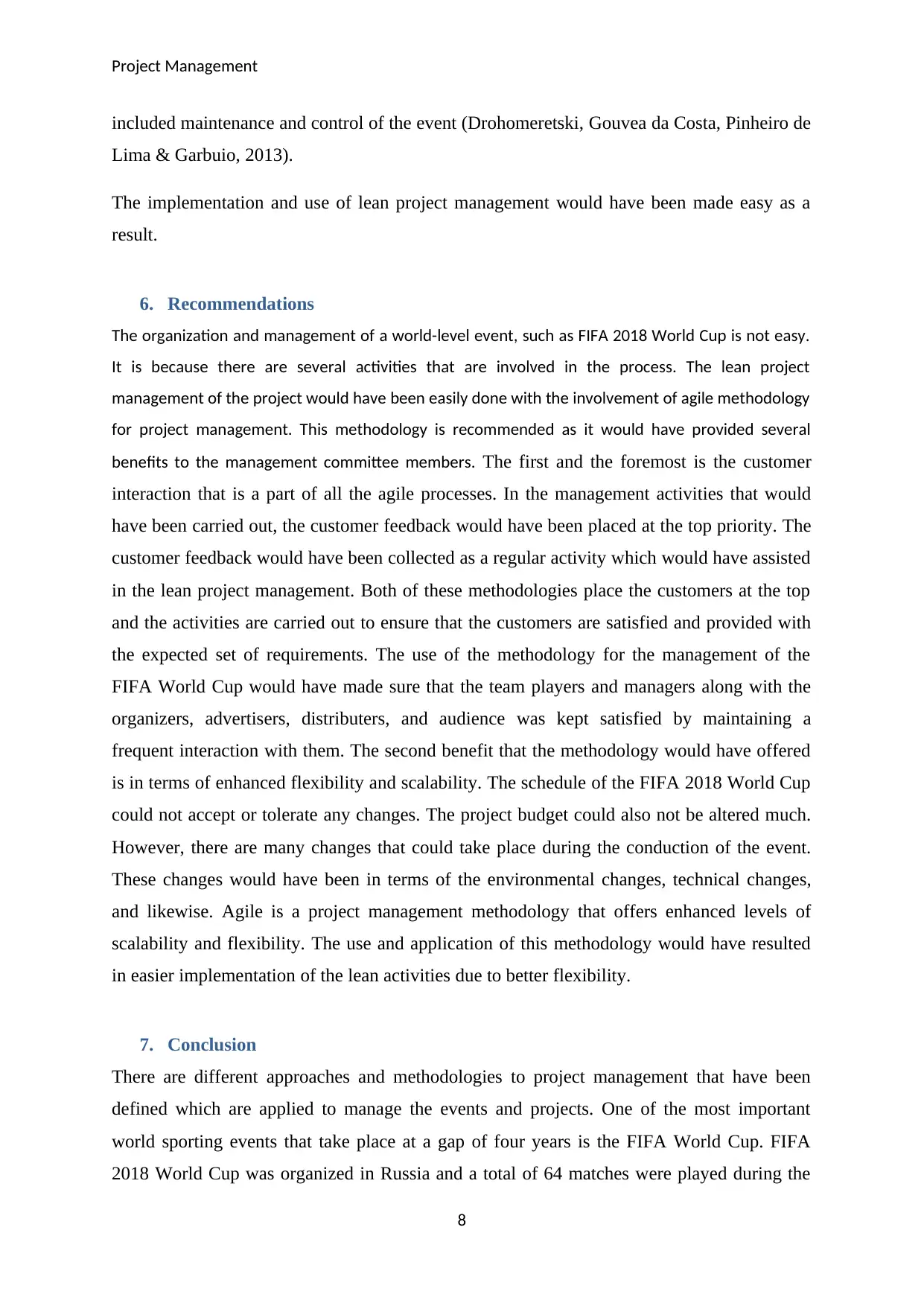
Project Management
included maintenance and control of the event (Drohomeretski, Gouvea da Costa, Pinheiro de
Lima & Garbuio, 2013).
The implementation and use of lean project management would have been made easy as a
result.
6. Recommendations
The organization and management of a world-level event, such as FIFA 2018 World Cup is not easy.
It is because there are several activities that are involved in the process. The lean project
management of the project would have been easily done with the involvement of agile methodology
for project management. This methodology is recommended as it would have provided several
benefits to the management committee members. The first and the foremost is the customer
interaction that is a part of all the agile processes. In the management activities that would
have been carried out, the customer feedback would have been placed at the top priority. The
customer feedback would have been collected as a regular activity which would have assisted
in the lean project management. Both of these methodologies place the customers at the top
and the activities are carried out to ensure that the customers are satisfied and provided with
the expected set of requirements. The use of the methodology for the management of the
FIFA World Cup would have made sure that the team players and managers along with the
organizers, advertisers, distributers, and audience was kept satisfied by maintaining a
frequent interaction with them. The second benefit that the methodology would have offered
is in terms of enhanced flexibility and scalability. The schedule of the FIFA 2018 World Cup
could not accept or tolerate any changes. The project budget could also not be altered much.
However, there are many changes that could take place during the conduction of the event.
These changes would have been in terms of the environmental changes, technical changes,
and likewise. Agile is a project management methodology that offers enhanced levels of
scalability and flexibility. The use and application of this methodology would have resulted
in easier implementation of the lean activities due to better flexibility.
7. Conclusion
There are different approaches and methodologies to project management that have been
defined which are applied to manage the events and projects. One of the most important
world sporting events that take place at a gap of four years is the FIFA World Cup. FIFA
2018 World Cup was organized in Russia and a total of 64 matches were played during the
8
included maintenance and control of the event (Drohomeretski, Gouvea da Costa, Pinheiro de
Lima & Garbuio, 2013).
The implementation and use of lean project management would have been made easy as a
result.
6. Recommendations
The organization and management of a world-level event, such as FIFA 2018 World Cup is not easy.
It is because there are several activities that are involved in the process. The lean project
management of the project would have been easily done with the involvement of agile methodology
for project management. This methodology is recommended as it would have provided several
benefits to the management committee members. The first and the foremost is the customer
interaction that is a part of all the agile processes. In the management activities that would
have been carried out, the customer feedback would have been placed at the top priority. The
customer feedback would have been collected as a regular activity which would have assisted
in the lean project management. Both of these methodologies place the customers at the top
and the activities are carried out to ensure that the customers are satisfied and provided with
the expected set of requirements. The use of the methodology for the management of the
FIFA World Cup would have made sure that the team players and managers along with the
organizers, advertisers, distributers, and audience was kept satisfied by maintaining a
frequent interaction with them. The second benefit that the methodology would have offered
is in terms of enhanced flexibility and scalability. The schedule of the FIFA 2018 World Cup
could not accept or tolerate any changes. The project budget could also not be altered much.
However, there are many changes that could take place during the conduction of the event.
These changes would have been in terms of the environmental changes, technical changes,
and likewise. Agile is a project management methodology that offers enhanced levels of
scalability and flexibility. The use and application of this methodology would have resulted
in easier implementation of the lean activities due to better flexibility.
7. Conclusion
There are different approaches and methodologies to project management that have been
defined which are applied to manage the events and projects. One of the most important
world sporting events that take place at a gap of four years is the FIFA World Cup. FIFA
2018 World Cup was organized in Russia and a total of 64 matches were played during the
8
⊘ This is a preview!⊘
Do you want full access?
Subscribe today to unlock all pages.

Trusted by 1+ million students worldwide
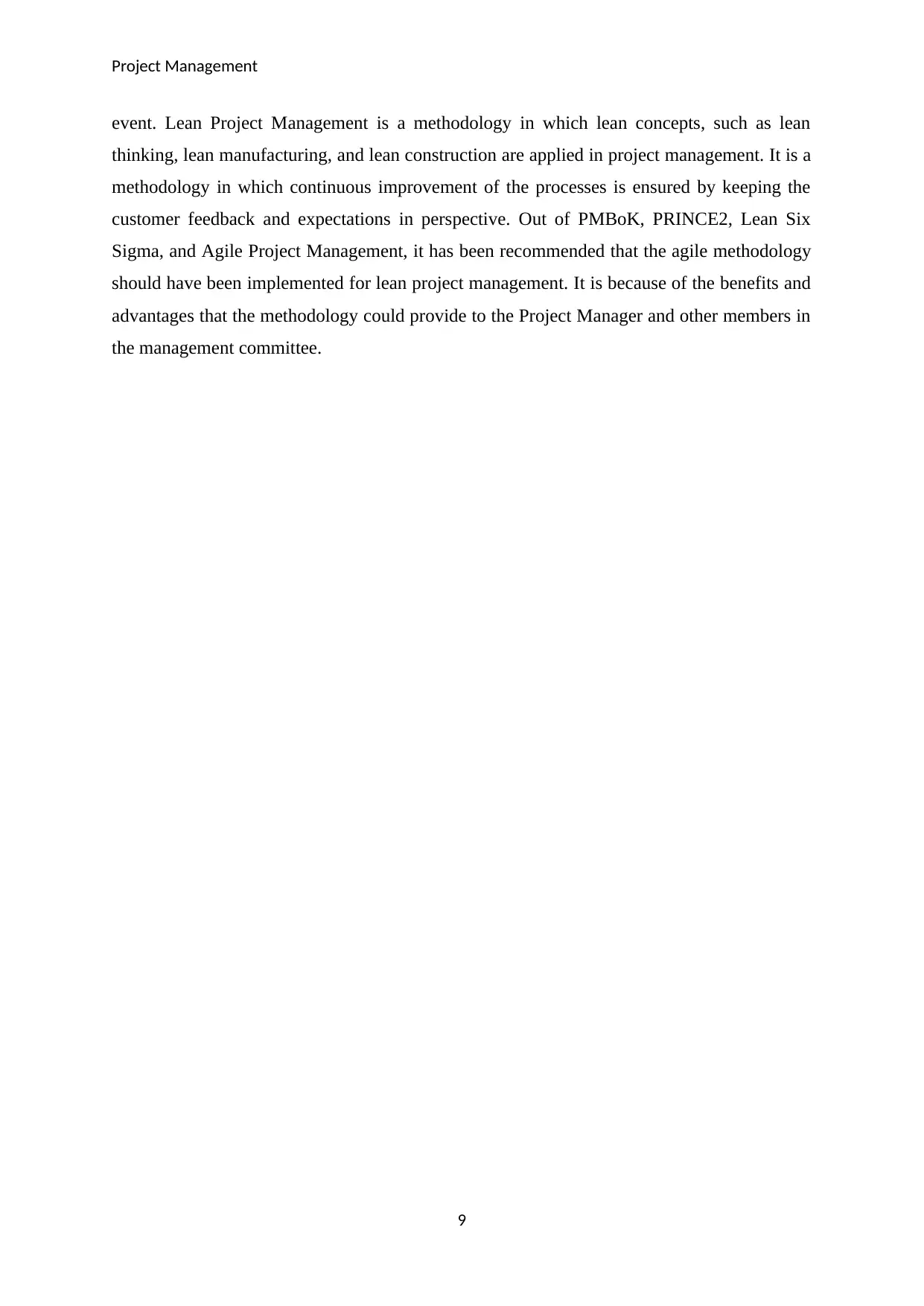
Project Management
event. Lean Project Management is a methodology in which lean concepts, such as lean
thinking, lean manufacturing, and lean construction are applied in project management. It is a
methodology in which continuous improvement of the processes is ensured by keeping the
customer feedback and expectations in perspective. Out of PMBoK, PRINCE2, Lean Six
Sigma, and Agile Project Management, it has been recommended that the agile methodology
should have been implemented for lean project management. It is because of the benefits and
advantages that the methodology could provide to the Project Manager and other members in
the management committee.
9
event. Lean Project Management is a methodology in which lean concepts, such as lean
thinking, lean manufacturing, and lean construction are applied in project management. It is a
methodology in which continuous improvement of the processes is ensured by keeping the
customer feedback and expectations in perspective. Out of PMBoK, PRINCE2, Lean Six
Sigma, and Agile Project Management, it has been recommended that the agile methodology
should have been implemented for lean project management. It is because of the benefits and
advantages that the methodology could provide to the Project Manager and other members in
the management committee.
9
Paraphrase This Document
Need a fresh take? Get an instant paraphrase of this document with our AI Paraphraser
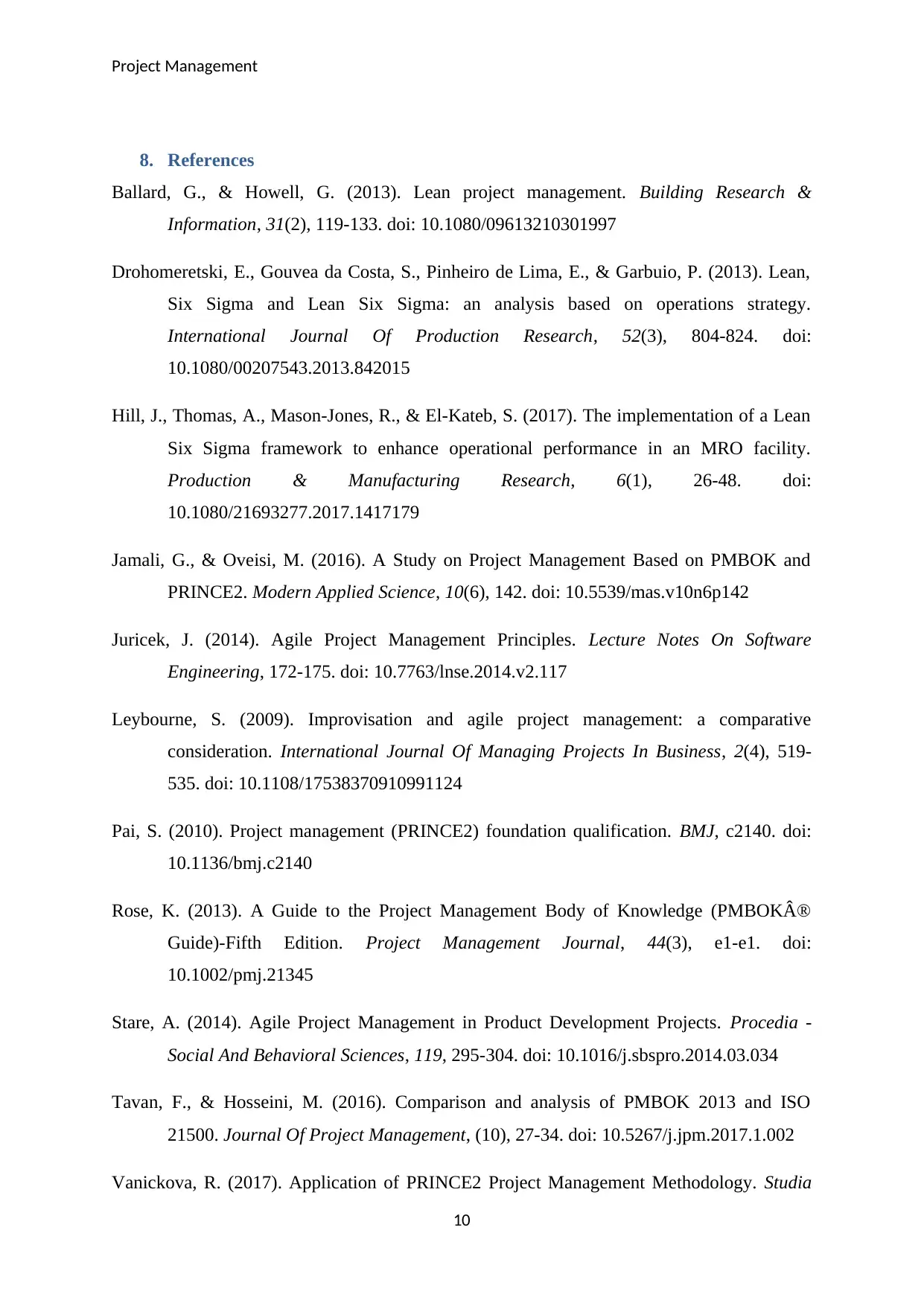
Project Management
8. References
Ballard, G., & Howell, G. (2013). Lean project management. Building Research &
Information, 31(2), 119-133. doi: 10.1080/09613210301997
Drohomeretski, E., Gouvea da Costa, S., Pinheiro de Lima, E., & Garbuio, P. (2013). Lean,
Six Sigma and Lean Six Sigma: an analysis based on operations strategy.
International Journal Of Production Research, 52(3), 804-824. doi:
10.1080/00207543.2013.842015
Hill, J., Thomas, A., Mason-Jones, R., & El-Kateb, S. (2017). The implementation of a Lean
Six Sigma framework to enhance operational performance in an MRO facility.
Production & Manufacturing Research, 6(1), 26-48. doi:
10.1080/21693277.2017.1417179
Jamali, G., & Oveisi, M. (2016). A Study on Project Management Based on PMBOK and
PRINCE2. Modern Applied Science, 10(6), 142. doi: 10.5539/mas.v10n6p142
Juricek, J. (2014). Agile Project Management Principles. Lecture Notes On Software
Engineering, 172-175. doi: 10.7763/lnse.2014.v2.117
Leybourne, S. (2009). Improvisation and agile project management: a comparative
consideration. International Journal Of Managing Projects In Business, 2(4), 519-
535. doi: 10.1108/17538370910991124
Pai, S. (2010). Project management (PRINCE2) foundation qualification. BMJ, c2140. doi:
10.1136/bmj.c2140
Rose, K. (2013). A Guide to the Project Management Body of Knowledge (PMBOK®
Guide)-Fifth Edition. Project Management Journal, 44(3), e1-e1. doi:
10.1002/pmj.21345
Stare, A. (2014). Agile Project Management in Product Development Projects. Procedia -
Social And Behavioral Sciences, 119, 295-304. doi: 10.1016/j.sbspro.2014.03.034
Tavan, F., & Hosseini, M. (2016). Comparison and analysis of PMBOK 2013 and ISO
21500. Journal Of Project Management, (10), 27-34. doi: 10.5267/j.jpm.2017.1.002
Vanickova, R. (2017). Application of PRINCE2 Project Management Methodology. Studia
10
8. References
Ballard, G., & Howell, G. (2013). Lean project management. Building Research &
Information, 31(2), 119-133. doi: 10.1080/09613210301997
Drohomeretski, E., Gouvea da Costa, S., Pinheiro de Lima, E., & Garbuio, P. (2013). Lean,
Six Sigma and Lean Six Sigma: an analysis based on operations strategy.
International Journal Of Production Research, 52(3), 804-824. doi:
10.1080/00207543.2013.842015
Hill, J., Thomas, A., Mason-Jones, R., & El-Kateb, S. (2017). The implementation of a Lean
Six Sigma framework to enhance operational performance in an MRO facility.
Production & Manufacturing Research, 6(1), 26-48. doi:
10.1080/21693277.2017.1417179
Jamali, G., & Oveisi, M. (2016). A Study on Project Management Based on PMBOK and
PRINCE2. Modern Applied Science, 10(6), 142. doi: 10.5539/mas.v10n6p142
Juricek, J. (2014). Agile Project Management Principles. Lecture Notes On Software
Engineering, 172-175. doi: 10.7763/lnse.2014.v2.117
Leybourne, S. (2009). Improvisation and agile project management: a comparative
consideration. International Journal Of Managing Projects In Business, 2(4), 519-
535. doi: 10.1108/17538370910991124
Pai, S. (2010). Project management (PRINCE2) foundation qualification. BMJ, c2140. doi:
10.1136/bmj.c2140
Rose, K. (2013). A Guide to the Project Management Body of Knowledge (PMBOK®
Guide)-Fifth Edition. Project Management Journal, 44(3), e1-e1. doi:
10.1002/pmj.21345
Stare, A. (2014). Agile Project Management in Product Development Projects. Procedia -
Social And Behavioral Sciences, 119, 295-304. doi: 10.1016/j.sbspro.2014.03.034
Tavan, F., & Hosseini, M. (2016). Comparison and analysis of PMBOK 2013 and ISO
21500. Journal Of Project Management, (10), 27-34. doi: 10.5267/j.jpm.2017.1.002
Vanickova, R. (2017). Application of PRINCE2 Project Management Methodology. Studia
10

Project Management
Commercialia Bratislavensia, 10(38), 227-238. doi: 10.1515/stcb-2017-0021
9. Diagrams
Agile Project Management
Lean Six Sigma DMAIC
11
Commercialia Bratislavensia, 10(38), 227-238. doi: 10.1515/stcb-2017-0021
9. Diagrams
Agile Project Management
Lean Six Sigma DMAIC
11
⊘ This is a preview!⊘
Do you want full access?
Subscribe today to unlock all pages.

Trusted by 1+ million students worldwide
1 out of 14
Related Documents
Your All-in-One AI-Powered Toolkit for Academic Success.
+13062052269
info@desklib.com
Available 24*7 on WhatsApp / Email
![[object Object]](/_next/static/media/star-bottom.7253800d.svg)
Unlock your academic potential
Copyright © 2020–2025 A2Z Services. All Rights Reserved. Developed and managed by ZUCOL.


